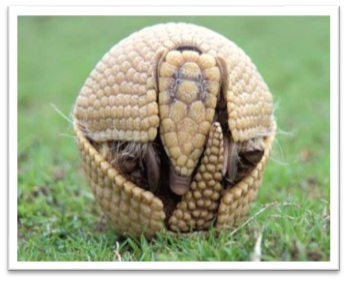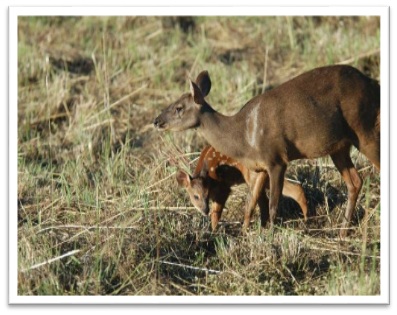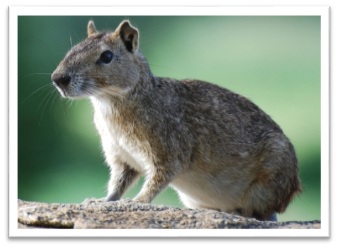THE TATÚ BOLA AND TATÚ PEBA
The tatu peba or peba is a name indigene’s origins of Brazil’s Tupi language ” tatu’pewa ” to “boring tatú ” in reference to the body shape of this species of armadillo, it has a pointed flat head. The sexcintus name is translated from Latin means “six belts ” because the animal’s shell is divided into six to eight plates (or straps) mobile. This shell strong and durable, coats the back part of the head and the tail has bone formation.
All five fingers of the previous leg have large and strong claws that are used to dig the ground and build dens. Together head and body are between 40 and 95 cm, and the tail adds another 12 to 24 cm. The weight of the animals ranges from 3.2 to 6.5 kg.
The tatú peba is from origin South American and can be found from Suriname to northern Argentina, including Bolivia, Uruguay, Guyana, Paraguay and Brazil. Here is common find in the Northeast, in savannas and foret. The states of Paraíba, Rio Grande do Norte, Pernambuco and Ceará. They can be found.
They are omnivorous,it feeds on a wide range of plants and animals, including carrion. Insects such as ants and termites and small vertebrates such as frogs are also part of the diet. But peba armadillo like is a salad. Plants comprising 90% of their diet and include fruits and seeds.
The shelter places are 2 meters deep soil, is used as a shelter and refuge for protection from predators.
Unlike most peba armadillo species are diurnal. Also are shy animals. Demarcate their territories through with the smell that exudes from their scent glands. If threatened, in general, they run to escape predators and strange animals, but can be aggressive towards members of their own species.
PLEASE VISIT WEBSITE:
www.youtube.com/watch?v=lRlujka5hs4
THE OUTBACK´S DEER
Scientific name: Mazama gouazoupira
Order: Artiodactyla
Family:Cervidae
Species:Mazama gouazoubira
Longevity: Average of 20 years.
Natural predators : jaguars Habitat: savannas
It is considered one of the most popular animals for irregular hunting in northeastern Brazil. The adult length ranging from 902 cm to 1.25 cm. The weight may vary between 11 to 25 kg, usually near the 17 kg. Only the male has horns that are simple, straight and without ramifications that reach 7-15 cm in length in adults. The female has a single calf weighing about 500g. The coat of the puppy is brown with white spots around the back.
They can be seen only in a few preserved in reserves located in small part of northeastern Brazil. You can see small volume deer (Mazama gouazoubira) this species is among the most endangered. Indiscriminate hunting is one of mariores constant threats. Large predators are community residents. And haitantes of cities near the reservation. They are coming to the end of the species. It’s hard to see them. One of the main threats comes from lack of water and food caused the devastation that man does. They live hidden in droves for reasons of dogs and hunters. This action of persecution usually occurs in nighttime without absence surveillance of protected areas.
The resilience of these animals are extraordinary. Because various types of threats. With the lack of water and the difficulties of finding food they still resist.
To preserve these animals and many other caatinga Bio-Animal want to make a more effective policy through a fully protected area. Being able to bring education and reforestation of the environment.
Sometimes you can find some with puppies. This confirms the precarious survival of the species in degraded savanna areas. And emergency measure necessary to preserve the urgent.
PLEASE VISIT WEBSITE:
www.youtube.com/watch?v=U4tt12rKtSI
THE 3 MOST BEAUTIFUL SPECIES WILDCAT BRAZIL NORTHEAST
Believes that the species of wild cats can reach the number of 40 and are found in various regions. They can be found in forests, mountains, cold and even in desert areas. The social behavior of wild cats is varied, the vast majority of species are solitary, others living in group. The game system may vary from active hunters, chasing the prey to catch it, and hunters prefer to patiently wait for prey approach. Some species use two hunting system by choosing the better. They are the largest predators of small domestic animals.
The eight species of Brazil’s cats are in the vulnerable category in the extinction threat status. The great part shows a pattern of spots that form rosettes on a light yellow color to yellowish brown. And the great majority are predominantly nocturnal behavior and solitary habit.
Maracajá Cat – Leopardus wiedii:
Found in the forests of Brazil, including in the cerrado. Adapted to arboreal life, moving around easily in the trees. Requires an area of up to 15,9km² to live. Unlike ocelot ounce by having smaller size (up to 60 cm), large eyes nose.
Small Wild Cat – Leopardus tigrinus: is the smallest cat species in Brazil, size similar to the domestic cat, can reach up to 50 cm long. It is found in Brazil to the north of Rio Grande do Sul in the areas of forest, savanna, scrub and nearby the nearby agricultural areas forests. You may have daytime behavior in some areas to live need area to 17.4 square kilometers.
Moorish Cat – Puma yagouaroundi: small – medium size can reach up to 70 cm long, with small and elongated head, small ears and short legs relative to the body. It features uniform color brownish – black, grayish or reddish-yellow. It is found in Brazil, except for the southern Rio Grande do Sul , living in forests, savanna, savanna, wetlands, secondary vegetation, etc. With living area quite varied and predominantly diurnal activity.
PLEASE VISIT WEBSITE:
www.youtube.com/watch?v=WHug2mBxDh0
www.youtube.com/watch?v=hA8sesbXkqw
www.youtube.com/watch?v=q8rezIxqtYw
THE POSSUM NORTHEAST
Is an animal popularly known as ticaca, skunk, opossum or. However its scientific name is striped Conepatus. It belongs to the order Carnivora, Mephitis, Mydaus and Spilogale.
The tacacá (striped hog-nosed skunk ) is a small mammal with a body length ranging from 30 to 52 cm and the tail between 16 and 31cm. Individuals weigh between 1.4 and 4.0kg.
In nature have as their main predator, the wild cat ( Leopardus spp.), While in the cities are often tramples of for having the vision overshadowed by the headlights and have little mobility except the trees.
Opossums can reproduce three times during the year giving ten to twenty chicks in each gestation, which lasts twelve to fourteen days. And are born only embryos with about one centimeter long heading into the bag. The pups stay in the pack up to four months and when they grow are not able to live alone are transported by the mother on her back.
The captivity the life is two to four year. The Opossums produce a liquid stinky through the axillary glands. This net and used by the animals as a defense. Another strategy to escape the dangers They also They also have a role to pretend predator dead to give up.
Some are immune to the venom of snakes, including pit vipers ( Bothrops sp.) Rattlesnakes (Crotalus spp.) And Coral (Micrurus spp.) Being able to attack them over his head. According to scientific studies of a lethal dose of an experiment with opossums was 660 milligrams of poison, which corresponds to a dose of 4 000 times higher than supported by four hundred kilograms of bovine.
PLEASE VISIT WEBSITE:
www.youtube.com/watch?v=uSkGXTsJ4Nk
THE MOCÓ OF NORTHEAST
The cavy (rupestris Kerodon) belong to the Order Rodentia, Caviidae Family and Gender Kerodon.
They are animals that adapt physiologically to a range of climates and altitudes. Characterized as land mammals, herbivores with adults measuring about 40 cm and can weigh up to 1 kg and dentition is devoid of canines. They have only three fingers in the hind limbs and tail completely atrophied.
Usually live in small colonies made holes in the rocks. They have diurnal habits. The Moco has been restricted to the region’s semi-arid Caatinga of Northeastern Brazil. The granitic rocks serve as their refuge, when threatened those predators are excellent jumpers climbing rocks and trees branches where they feed on the leaves. The Longevity do Mocó in Captivity is about 11 years presenting social behavior and training of family groups
These animals are subject to intense action of hunters, by its size and tasty meat very appreciated by the rural population. Many popular in local cuisine. They are also used in cheese production. We should also add that some of these rodents bury the seeds that are part of their diet, contributing to reforestation.
We consider very important the conservation of these animals so important to the region.
All animals we mentioned our project, the local resident believed that could never be extinguished by large existing amount at the time. So they do not believe in a possible extinction because its was very favorable conditions of procreation. Because fires, poaching and consecutive droughts. Our Bio Animal foundation is detecting and calling attention to an emergency situation. We need to take providences to the environmental impact that is in great warning sign. If we do not take quick action these animals have disappeared in a few years.
This animals and plants of the northeast ask for help It is necessary to start a new concept of restoration, urgent preservation. This is our commitment.
PLEASE VISIT WEBSITE:





